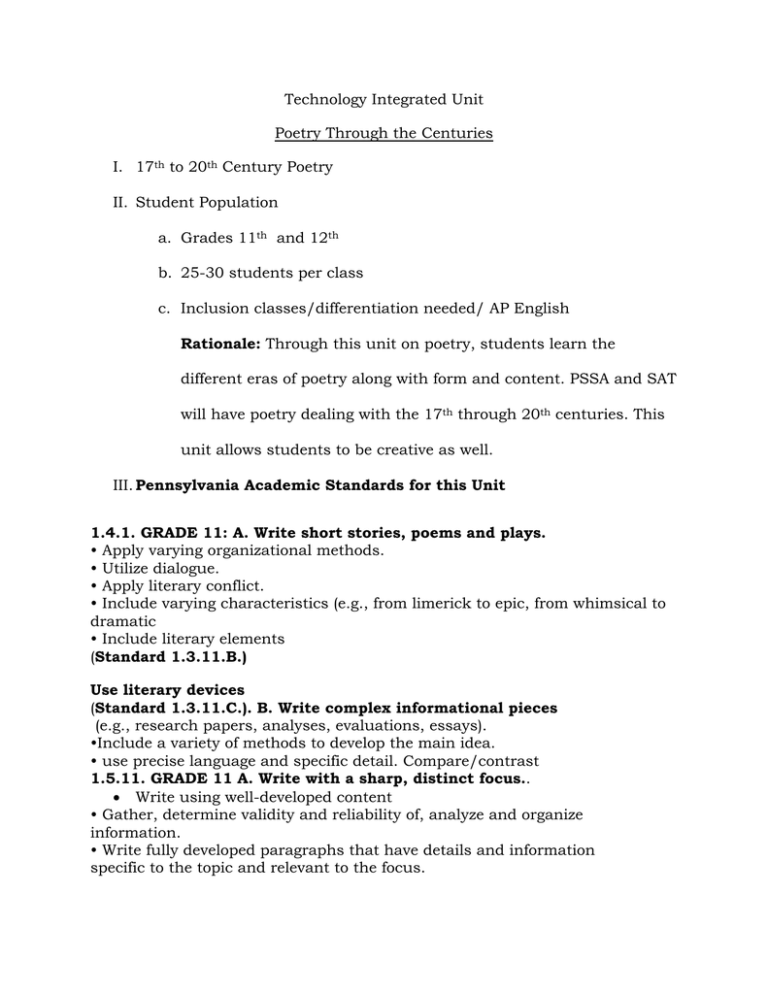
Technology Integrated Unit
Poetry Through the Centuries
I. 17th to 20th Century Poetry
II. Student Population
a. Grades 11th and 12th
b. 25-30 students per class
c. Inclusion classes/differentiation needed/ AP English
Rationale: Through this unit on poetry, students learn the
different eras of poetry along with form and content. PSSA and SAT
will have poetry dealing with the 17th through 20th centuries. This
unit allows students to be creative as well.
III. Pennsylvania Academic Standards for this Unit
1.4.1. GRADE 11: A. Write short stories, poems and plays.
• Apply varying organizational methods.
• Utilize dialogue.
• Apply literary conflict.
• Include varying characteristics (e.g., from limerick to epic, from whimsical to
dramatic
• Include literary elements
(Standard 1.3.11.B.)
Use literary devices
(Standard 1.3.11.C.). B. Write complex informational pieces
(e.g., research papers, analyses, evaluations, essays).
•Include a variety of methods to develop the main idea.
• use precise language and specific detail. Compare/contrast
1.5.11. GRADE 11 A. Write with a sharp, distinct focus..
Write using well-developed content
• Gather, determine validity and reliability of, analyze and organize
information.
• Write fully developed paragraphs that have details and information
specific to the topic and relevant to the focus.
C. Write with controlled and/or subtle organization
• Sustain a logical order throughout the piece.
• Include an effective introduction and conclusion.
D. Write with a command of the stylistic aspects of composition.
• Use different types and lengths of sentences.
• Use precise language.
E. Revise writing to improve style, word choice, sentence variety and subtlety
of meaning after rethinking how questions of purpose, audience and genre
have been addressed.
F. Edit writing using the conventions of language.
• Spell all words correctly.
• Use capital letters correctly.
• Punctuate correctly
• Use nouns, pronouns, verbs, adjectives, adverbs, conjunctions, prepositions
and interjections properly.
1.6.11 Speaking and Listening
1.7.C.A Evaluate as a reader how an author’s choice of words.
1.9. C. Information, communication and Technology literacy
Use media and technology resources for information analysis, and
decision making in content learning.
IV. Goals: Students will brainstorm on the topics, “What is poetry?” “Why”
a. Help students gain a broader conception of poetry. Through unit
lessons, students will recognize the different authors as well as forms
of poetry. Students will create their own poem for portfolio. Students
will create a poetry folder.
V. Technology Integrated Unit (See my Wiki for Actual lesson plans)
a. Introduction Lesson: Through this introduction of music and
poetry, students will find a connection with elements of poetry,
such as, rhythm and rhyme. Students will find this evidence and
be motivated for culminating lessons.
b. Developmental 1: Through PowerPoint on “Elements of Poetry”
students will recognize different forms of poetry. Students will
choose a poem they are interested in.
c. Developmental 2: Through computer integrated lessons, students
will together as a class, explore an interactive poetry website,
“Poetry’s Pantry Tour”
d. WebHunt: Through technology, students will complete a web hunt
on 17th century poetry, in particular, metaphysical and Cavalier
poetry, that they will learn about in this unit.
e. WebQuest: Students will complete a webQuest, culminating the
poetry unit. They will analyze, distinguish poetry form, explore the
“Nature” theme in poetry and create their own works of poetry.
Students will complete with accuracy for credit.
f. Culminating Lesson: After lessons on poetry unit, students will
create a poetry folder using internet sites from classroom Wiki
(Resource Page). Students will make a list of favorite poets/poems
from each of the centuries 17th through 20th. As a class, we will
discuss which poets/poetry we have collected for our folders.
VI. Assessment Strategies
a. Introduction: Use informal assessment checklist for class
discussion/ journals
b. Lesson 1: informal assessment/ class checklist/journals
c. Lesson 2: tour checklist for students/ put in journals
d. WebHunt: students are evaluated by webHunt assignment
e. WebQuest: Portfolio: Detailed essay rubric (scale) Detailed
summary rubric Poetry rubric
f. Culminating lesson: poetry folder/informal/to be collected
VII.
Additional Resources
a. Introduction: Internet, Anticipation Guide
b. Lesson 1: Computer/ PowerPoint
c. Lesson 2: Computer Lab/ internet
d. WebHunt: worksheet/ internet
e. WebQuest: Rubrics/ internet
f. Culminating lesson: Computer Lab/ internet/ folder
VIII. Webliography
a. For unit plan on Poetry
b. WebHunt
c. WebQuest
1. Introduction Lesson
BiG, N. (Artist). (2001). Mo money more problems. [Web].
Retrieved from
http://www.youtube.com/watch?v=kUJ4ApgZF6k
Zeppelin, L. (Artist). (1971). Stairway to heaven. [Web].
Retrieved from http://www.youtube.com/watch?v=w9TGj2jrJk8
2. Developmental lesson 1
Web English Teacher, all rights reserved, S. (Designer). (2008).
"Poetry terminology.” [Web]. Retrieved from
http://www.webenglishteacher.com/
3. Developmental lesson 2
Tramline, T. (2005, Sept). Poetry's pantry tour. Retrieved from
http://field-trips.org/tours/lit/poet/playtour.htm
4. WebHunt
Ms. Ewart’s English Odyssey/ WebHunt Page
http://sewart.wikispaces.com/
1. http://faculty.mccfl.edu/Jonesj/Enl2010/MetaphysicalandCavalier.htm
2. http://www.luminarium.org/sevenlit/metaintro.htm
3. http://www.librarything.com/work/51578
4. http://www.teachit.co.uk/armoore/poetry/metaphys.htm
5. http://www.infoplease.com/ce6/ent/A0810943.html
6. http://www.luminarium.org/sevenlit/
7. http://www.luminarium.org/sevenlit/
8. http://www.wwnorton.com/college/english/nael/17century/welcome.htm
9. http://www.luminarium.org/sevenlit/lovelace/lucastaseas.htm
10. http://www.luminarium.org/sevenlit/donne/goodmorrow.php
5. WebQuest: Poetry webquest
http://teacherweb.com/WQ/HighSchool/poets
6. Culminating Lesson
Ms. Ewart’s English Odyssey/ Class Resource Page to create
folder
http://sewart.wikispaces.com/



